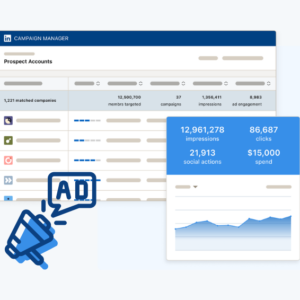In e-commerce, standing out in a crowded marketplace can take time and effort. With so many online stores competing for customers’ attention, business owners must find creative ways to differentiate themselves from their competitors.
7 Ways to Stand Out in a Crowded Marketplace
This article discovers different ways that businesses can achieve better position themselves in a crowded marketplace.
Work on User Experience

One way e-commerce businesses stand out is by optimizing their website design with user experience (UX) in mind. A well-designed e-commerce site should make it easy for shoppers to find what they want quickly. It offers an intuitive shopping process with minimal steps required to complete transactions. Taking the time to evaluate customers’ feedback and use analytics tools to identify weak points can help e-commerce businesses hone their UX and create a better shopping experience.
E-commerce has become an essential part of the modern and crowded marketplace. With online stores, business owners have access to global markets, and consumers can access products and services from around the world with just a few clicks.
Advantages of a Developed UX
User Experience is a critical factor in e-commerce success because it ensures that customers have a positive and productive experience when interacting with an e-commerce platform.
- UX practices are designed to make e-commerce platforms more intuitive and user-friendly. These practices include: making sure that navigation between pages is easy,
- providing product descriptions in clear language,
- offering multiple payment options at checkout,
- streamlining the checkout process, displaying accurate product information, including customer reviews and ratings on products,
- creating detailed product categories for easier browsing,
- Provision of fast loading times and offer helpful customer support.
With the right User Experience strategies, e-commerce stores can become more user-friendly, trustworthy, and profitable.
Examples
One example is designing an easy-to-navigate website structure with intuitive menus and search functions that make it effortless for shoppers to find what they’re looking for. By ensuring that e-commerce platforms follow best practices in User Experience, business owners can help guarantee a successful online shopping experience for their customers and increase their bottom line.
- Products Displaying
Companies should also consider displaying related products on product pages to encourage additional purchases and upsells. Additionally, companies can leverage personalization techniques such as recommending products based on past purchases or providing tailored content like banner ads specifically aimed at individual users.
- Useful Features
Another example is offering convenience features such as one-click checkout and live chat support. It can help make the customer experience more enjoyable, as shoppers don’t have to remember lengthy passwords or struggle with complicated payment forms. Live chat lets customers get their questions answered quickly and easily without leaving the website.
- Learning User Behaviour on a Website
Finally, companies should consider using analytics to understand user behavior better and optimize UX design accordingly. By tracking customer interactions on their websites, companies can gain valuable insights into which aspects of the site are working well and which need improvement. This data can then be used to tweak design elements for maximum effectiveness.
By taking advantage of these examples of UX strategies in e-commerce, companies can create a shopping experience that is both efficient and enjoyable for their customers.
Search Engine Optimization

In the crowded marketplace, business owners should also focus on increasing visibility by optimizing their e-commerce websites for search engine optimization (SEO). It will help drive more organic traffic to the e-commerce store and improve the ranking of web pages in search results.
Advantages of SEO
Correctly optimized titles, descriptions, and content can make it easier for customers to find products online. Additionally, engaging with customers via social media channels and regularly creating fresh content can keep shoppers returning to the e-commerce site.
Examples
Regarding SEO, many best practices can help you attract more clients. Here are some examples that businesses of all sizes should consider:
- Develop your online presence and optimize content
Start creating an online store optimized for keywords relevant to your business. For example, you can use tools like Google Keyword Planner to identify the highest volume words and phrases related to your products or services. In addition, make sure your website is mobile-friendly, as this will help drive organic search traffic from users on devices such as smartphones and tablets.
- Utilize social media marketing
Social media is a powerful tool for driving potential customers to your website. Make sure you post regularly with relevant content that showcases your products or services. You can also use social media to establish relationships with existing customers and build trust with potential customers who may need to become familiar with your business.
- Invest in SEO specialists
To get the most out of your SEO efforts, we recommend investing in an experienced SEO specialist. These professionals will be able to identify the best keywords and phrases related to your business and create content optimized for search engine algorithms. They can also help you analyze traffic sources and adjust strategies accordingly.
By following these best practices, businesses of all sizes can ensure a successful SEO strategy and attract more customers online.
Innovations for eCommerce

Innovations can help online stores stand out from the crowd and make them more appealing to customers. By utilizing new technologies, online stores can provide a unique experience that sets them apart from their competitors.
There are examples of many innovations that help eCommerce stores stand out from the competition. Specialists in this area have identified strategies for online shops to get ahead. These include:
Personalization and Customization Technologies
Personalization and customization technologies have revolutionized e-commerce, allowing retailers to tailor their offerings and experiences to customers’ individual needs. In many cases, e-commerce companies have adopted these technologies to enhance customer experience, increase conversions, and drive loyalty.
- Amazon’s “recommended for you” feature
For example, Amazon’s “recommended for you” feature uses machine learning algorithms and customer data analysis to provide users with personalized product recommendations based on past purchases or browsing history. This technology can be very effective in helping shoppers find products they may not have thought of otherwise.
- Zappos’ “smart search” feature
Another example is Zappos’ “smart search” technology which allows users to quickly search through an expansive catalog by providing multiple ways to filter and refine results. For example, customers can search for items according to gender, size, color, style, and other criteria. It is an excellent way for customers to quickly find what they are looking for without scrolling through hundreds of items.
These cases demonstrate how e-commerce companies have used personalization and customization technologies to offer an improved shopping experience. In addition, these technologies can be applied in many contexts, such as product recommendations, automated marketing campaigns, personalized customer service experiences, and more.
Communicate with People
Utilizing omnichannel marketing techniques by providing multiple contact points between customers and the store; this could involve using social media platforms, email campaigns, or even physical pop-up events.
What is Omnichannel Marketing?
Omnichannel marketing is a powerful tool for e-commerce businesses. It involves multiple channels to engage customers, drive sales, and build relationships. Various techniques can help e-commerce companies succeed with omnichannel marketing.
- Case Studies
One technique is to create cases and examples demonstrating how customers have benefited from using your products or services. By presenting real issues showcasing success, you can give potential customers an idea of what they can expect if they do business with you. In addition, it helps create a positive impression of your brand and motivates them to purchase from you.
- Social Media
Another technique is to use social media channels such as Facebook or Instagram to grow awareness about your company’s offerings and interact directly with your customers. For example, you can create posts about new products, promotions, or other exciting news to capture the attention of potential buyers. It can help you reach a larger audience and build customer relationships.
- Different Target Audiences
Finally, you should continually measure and analyze customer data to better understand their behavior and preferences. Knowing which channels drive sales and how people interact with your brand is essential for optimizing omnichannel marketing strategies. By gathering this insight, you can make informed decisions that will help improve your performance over time.
In conclusion, omnichannel marketing techniques such as creating cases and examples, utilizing social media channels, and measuring customer data can be incredibly beneficial for e-commerce businesses.
Build Brand Identity
Developing a solid brand identity through consistent messaging across all channels; involves having a unified tone of voice and a set of visual elements that reinforce the store’s unique identity. Here are some cases and examples of how strong brand identity helps e-commerce:
- Brand Recognition
A strong brand identity makes it easy for customers to recognize a company’s products or services. It allows customers to make informed decisions about what they buy based on previous experiences with the company or their positive impressions of its branding.
- Building Trust
Branding enables companies to build trust with their customers by providing them with a consistent experience across all platforms and devices. This trust can be further reinforced by displaying customer reviews and ratings on the website, which helps to build customer confidence in the quality of the product or service.
- Increasing Visibility
A strong brand identity can increase visibility for a company’s products and services, as customers are more likely to seek out companies they recognize and trust. It could be achieved by using effective SEO strategies, such as optimizing content for search engine rankings.
- Enhancing Customer Loyalty
Customers who have a positive experience with a company’s products or services will be more likely to return if they feel they have developed a connection with its brand identity.
Artificial Intelligence and Machine Learning

Leveraging artificial intelligence (AI) and machine learning (ML) to provide customers with a tailored experience; could involve using AI-enabled chatbots or ML-backed product recommendations, which can help create an interactive experience for shoppers.
Predict User Behavior
Machine learning algorithms can make predictions based on customers’ past purchases or browsing history to tailor the recommended products to their interests. AI can also optimize pricing models by analyzing customer data and market trends to determine the optimal price for each product. Finally, AI can be used for fraud detection and prevention as well as automation of customer service inquiries. As a result, companies can improve the customer experience by employing AI-driven solutions while reducing costs.
Leveraging artificial intelligence and machine learning in e-commerce cases can help to increase sales, optimize pricing models, detect fraud and automate customer service inquiries – leading to improved customer experiences.
Develop Campaigns
Lastly, e-commerce businesses should develop unique marketing campaigns tailored specifically to their target audience. When you develop campaigns for eCommerce, consider the following:
- Target Different Groups
Creating targeted content is essential because it allows you to reach potential customers who are likely interested in your product or service. You can use data from analytics platforms such as Google Analytics to determine which types of content appeal to your target market and create more of that type of content. Additionally, posting regularly on social media channels like Twitter and Instagram will help ensure that you reach people already searching for what you have to offer.
- Invite Influencers

Engaging influencers is another great way to spread the word about your online store. Influencers have a large following, so if you can get them to post about your special offers and discounts, it can reach a much wider audience than if you were doing it yourself.
- Use Versatile E-Commerce Tools
Furthermore, automation tools like email marketing platforms and customer relationship management (CRM) systems can help streamline operations and keep customers up-to-date with new products or services. By automating mundane tasks such as sending out promotional emails or organizing contacts, you can free up time for more effective strategies.
- Delegate Tasks to Specialists
Finally, partnering with specialists who understand the nuances of digital marketing is another excellent way to boost your eCommerce campaigns. Specialists — such as those specializing in SEO, content marketing, and paid advertising — can help you create effective strategies to increase your online presence and reach more customers. You can get the most out of your eCommerce campaigns by working with specialists who deeply understand digital marketing.
Conclusion
In summary, check what you can implement to your online store at the development stage you are in now. We wish you good luck in your online store development!
The battle can be tough in a crowded marketplace. But you can stand out effectively in a crowded marketplace by understanding your competition and your target audience. You should focus on your niche and try to give the best to your customers.






